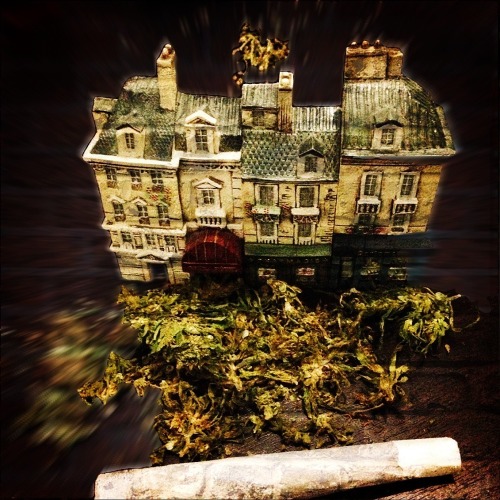#ankara

Mavi gözlüm… Yarın saat 9:05 geçtiğinde sirenler acı acı çalarken gözleri dolan evlatların olduğu sürece, sen hep yaşayacaksın Mustafam Kemalim

Sen benim huzurum, sen benim yolumsun
Seni anlamak ve seni anlatmak bana verilen en değerli hediyedir…
Miss Amsterdam soo much! Maybe i should take a trip soon, smoke and chill with nice people all around the town!
Post link

What is a Pinafore?
A collarless sleeveless dress worn over a blouse or shirt.
Pinafores may be worn by girls as a decorative garment and by both girls and women as a protective apron. A related term is pinafore dress (known as a jumper in American English), i.e. a sleeveless dress intended to be worn over a top or blouse. A key difference between a pinafore and a jumper dress is that the pinafore is open in the back. In informal British usage, however, a pinafore dress is sometimes referred to as simply a pinafore, which can lead to confusion.
Enough with the boring details….

The pinafore in this region have typically been associated with Secondary/High school and boarding house Set-ups. Therefore unconsciously isolates the attire as one not to be explored, ventured or recreated. Let’s be realistic, how many times have you considered the pinafore a fashion choice for an occasion? Hardly, right?!
Today, we want to visually wipe this stereotype. Pinafores don’t have to be boring, they can be fun too and worn to suit each unique style.
Click to Post

Fabric covered bead necklace – DIY tutorial
Hello lovelies. Its another Saturday and DIY projects are back!! for the enthusiastic and creatives out there here’s a well edited stream for your consumption. something you can rock this weekend. Ready?!!
Fabric covered bead necklaces
Yes, they are trendy and we’re sure you want to make my own. So head to a fabric store to buy a small piece of silky fabric (Hell yes to Ankara or any African print fabric) and here is the result.
To make the necklace lightweight and comfortable to wear, I used spun cotton balls (lightweight craft balls made of paper). I thought wooden beads would be too heavy and polystyrene balls would be too messy.
I am very happy with the way the necklace turned out. It looks great and feels comfortable around the neck.
It did take me longer than planned to make the necklace but that’s because I didn’t have a sewing machine.

Materials
14 spun cotton balls, 1.18″ diameter (30mm).
A 4.5″ x 90″ strip of silk fabric. At the store, the fabric I chose came on a 45″ wide bolt. So I asked for a foot of it which gave me what I needed plus a little extra.
Needle and some extra strong thread. Or a sewing machine. (I wish I had one)
A long ruler, pencil, scissors, or craft knife, paper clip.
Directions
Step 1: Cut a long and narrow strip of fabric (4.5 inches x 7.5 feet)

At the fabric store, you probably will not find a piece of fabric that is 7.5 feet long. Fabric comes on bolts and bolts are typically 36″, 44″-45″, or 54″ wide. So you may have to sew two pieces of fabric together.
The fabric I bought came on a 45″ wide bolt. So I ended up having to sew two long and narrow strips of fabric together to achieve the required length.
To cut the fabric, I used a long ruler and a craft knife over a piece of plywood. I cut two strips, each measuring 4.5″x 45″. It’s ok to use a pair of scissors if you don’t want to mess with a sharp knife. The cut doesn’t have to be exactly straight.
Before sewing the 2 strips together, I overlapped them by about an inch.
Step 2: Fold the strip of fabric into a tube shape
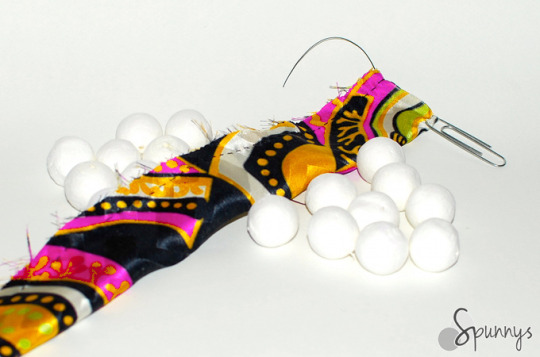
Fold the long piece of fabric in half lengthwise and sew the long edges together. Try to sew small stitches for a more secure seam. This is easy to accomplish but time consuming without a sewing machine.
VERY IMPORTANT: For now, the “good” side of the fabric goes inside the tube. We will turn the tube inside out once the sewing is done.
Once done with sewing, turn the tube inside out with a loop turner or a paper clip.
The paper clip method: Start by solidly anchoring the paper clip to one end of the tube (it’s ok to poke a hole in the fabric with the paper clip). Then, just slide the clip through the tube from one end to the other. The tube will turn inside out very easily.
Step 3: Slide in the spun cotton balls and tie the knots
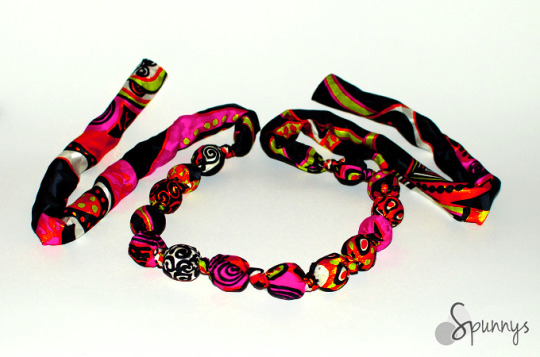
Tie the first knot where you sewed the two strips of fabric together (to hide the stitches).
Slide a ball down one end of the tube until it reaches the middle of the necklace. Twist the fabric to push the ball as close to the middle as possible and tie a simple knot.
Slide a second ball down the other end of the tube, twist the fabric and tie a new knot.
Do the same with all the balls or until the desired necklace length has been reached.
Step 4: The finishing touches

For the endings to look nice, fold the fabric to create a 45 degree angle. Sew along the edges.
Iron your fabric covered bead necklace on low heat to remove all the wrinkles. THIS IS IT!
A beautiful fabric covered hand knotted bead necklace
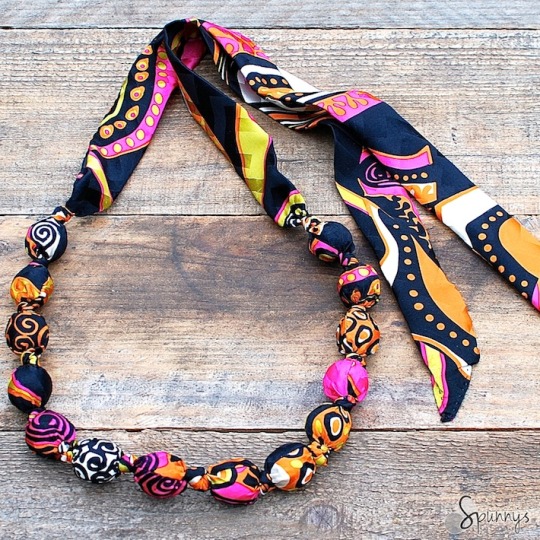
I hope you enjoyed this tutorial. As always, if you have any questions, do not hesitate to get in touch. Happy crafting!
Courtesy: https://www.pinterest.com/source/spunnys.stfi.re
Edited by: Samantha Equere.
Click to Post

Fabric covered bead necklace – DIY tutorial
Hello lovelies. Its another Saturday and DIY projects are back!! for the enthusiastic and creatives out there here’s a well edited stream for your consumption. something you can rock this weekend. Ready?!!
Fabric covered bead necklaces
Yes, they are trendy and we’re sure you want to make my own. So head to a fabric store to buy a small piece of silky fabric (Hell yes to Ankara or any African print fabric) and here is the result.
To make the necklace lightweight and comfortable to wear, I used spun cotton balls (lightweight craft balls made of paper). I thought wooden beads would be too heavy and polystyrene balls would be too messy.
I am very happy with the way the necklace turned out. It looks great and feels comfortable around the neck.
It did take me longer than planned to make the necklace but that’s because I didn’t have a sewing machine.

Materials
14 spun cotton balls, 1.18″ diameter (30mm).
A 4.5″ x 90″ strip of silk fabric. At the store, the fabric I chose came on a 45″ wide bolt. So I asked for a foot of it which gave me what I needed plus a little extra.
Needle and some extra strong thread. Or a sewing machine. (I wish I had one)
A long ruler, pencil, scissors, or craft knife, paper clip.
Directions
Step 1: Cut a long and narrow strip of fabric (4.5 inches x 7.5 feet)

At the fabric store, you probably will not find a piece of fabric that is 7.5 feet long. Fabric comes on bolts and bolts are typically 36″, 44″-45″, or 54″ wide. So you may have to sew two pieces of fabric together.
The fabric I bought came on a 45″ wide bolt. So I ended up having to sew two long and narrow strips of fabric together to achieve the required length.
To cut the fabric, I used a long ruler and a craft knife over a piece of plywood. I cut two strips, each measuring 4.5″x 45″. It’s ok to use a pair of scissors if you don’t want to mess with a sharp knife. The cut doesn’t have to be exactly straight.
Before sewing the 2 strips together, I overlapped them by about an inch.
Step 2: Fold the strip of fabric into a tube shape
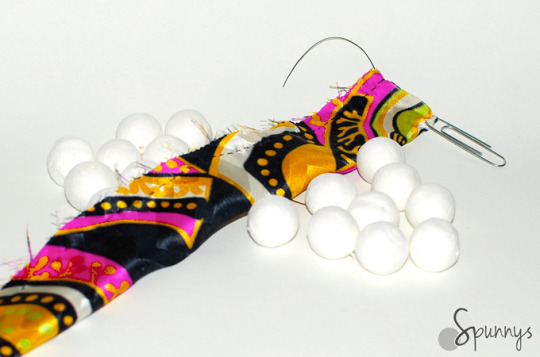
Fold the long piece of fabric in half lengthwise and sew the long edges together. Try to sew small stitches for a more secure seam. This is easy to accomplish but time consuming without a sewing machine.
VERY IMPORTANT: For now, the “good” side of the fabric goes inside the tube. We will turn the tube inside out once the sewing is done.
Once done with sewing, turn the tube inside out with a loop turner or a paper clip.
The paper clip method: Start by solidly anchoring the paper clip to one end of the tube (it’s ok to poke a hole in the fabric with the paper clip). Then, just slide the clip through the tube from one end to the other. The tube will turn inside out very easily.
Step 3: Slide in the spun cotton balls and tie the knots

Tie the first knot where you sewed the two strips of fabric together (to hide the stitches).
Slide a ball down one end of the tube until it reaches the middle of the necklace. Twist the fabric to push the ball as close to the middle as possible and tie a simple knot.
Slide a second ball down the other end of the tube, twist the fabric and tie a new knot.
Do the same with all the balls or until the desired necklace length has been reached.
Step 4: The finishing touches

For the endings to look nice, fold the fabric to create a 45 degree angle. Sew along the edges.
Iron your fabric covered bead necklace on low heat to remove all the wrinkles. THIS IS IT!
A beautiful fabric covered hand knotted bead necklace

I hope you enjoyed this tutorial. As always, if you have any questions, do not hesitate to get in touch. Happy crafting!
Courtesy: https://www.pinterest.com/source/spunnys.stfi.re
Edited by: Samantha Equere.
Click to Post

Following the three attacks that took place in Brussels, yesterday morning (Tuesday, March 22), and which are reported to have taken 30 lives, the people of Belgium have received massive support coming from all over the world. Some even likened the case to that of Paris (November 13, 2015). Thereafter, diverse sympathetic and reassuring articles, images and videos, have emerged on social media.
I – as a human being – condemn such barbaric and politically-motivated terrorist acts. But, Je suis Bruxelles or Je suis Paris? Well, regardless of my belongings; of where I am from and who I might be, I am neither Brussels nor Paris. Why? Because before it had occurred in Paris or Brussels, let us not forget the fact that it had actually occurred somewhere in the world. Both of Paris and Brussels belong to the world before they belong to France and Belgium. Let us not forget that those who died in Paris and Brussels where actually human beings before they ever were French or Belgian. And also, numerous other countries have known such acts. Therefore, and more importantly, terrorism is an act against humanity more than it is an act against a specific country, ethnicity religion or ideology.
Since Paris, there have been literally hundreds of terrorist attacks around the world, but sadly many of them have gone unnoticed.
Bamako, Mali (November 20, 2015): 20 dead.
A group of al-Qaeda-linked militants took 170 people hostage, ultimately killing 20, during a mass shooting at a Radisson Blu hotel in Bamako.
Tunis, Tunisia (November 24, 2015): 13 dead.
A bus loaded with Tunisian presidential guards was struck by a suicide bomber linked to the so-called Islamic State. The lone bomber killed 13 people.
Istanbul, Turkey (January 12, 2016): 13 dead.
A suicide bombing in a popular central square in Istanbul, Turkey’s largest city, left 13 people dead and 14 people injured.
Jakarta, Indonesia (January 14, 2016): 8 dead.
A series of suicide bombings and shootings in Indonesia’s capital left eight people dead, including four assailants. Another 24 people were wounded.
Ouagadougou, Burkina Faso (January 15, 2016): at least 30 dead.
A group of al-Qaeda backed militants attacked the Splendid Hotel in Ouagadougou. At least 30 people were killed, and another 56 were wounded.
Ankara, Turkey (February 17, 2016): At least 29 dead.
At least 29 people were killed and another 60 people were injured. The attack was carried out by a car bomb
Mogadishu, Somalia (February 25, 2016): At least 15 dead.
After a suicide bomber detonated a bomb at the gate of the SYL hotel, at least 15 people and left others wounded.
Ankara, Turkey (March 13, 2016): 37 dead.
A second attack in Ankara this year saw the deaths of 37 people and another 127 people injured.
Istanbul, Turkey (March 19, 2016): At least 4 dead.
At least four people were killed by a suicide bomber, another 36 people were wounded by the attack on Istanbul’s main shopping street.
But why does a Western life matter more than any other one does? The world does not only revolve around the West, does it? Is Islam to blame?
As mentioned before, between the two tragedies (those of Paris and Brussels), Muslim-majority countries such as Tunisia, Mali, Egypt, Turkey and doubtlessly Syria & Iraq also suffered from such deadly ‘Islamic’ acts.
Either before or after the two tragedies, of which ISIS claimed full responsibility, Muslims have always been ISIS’ closest and main target. Especially those in Syria whom, if not affected by terrorism itself, they are being affected by 'the war against terrorism’.
According to the Syrian Centre for Policy Research, 470,000 have been killed during the time period between 15 March 2011 and 11 February 2016.


Terrorism is an act against humanity more than it is an act against a specific country, ethnicity religion or ideology.











